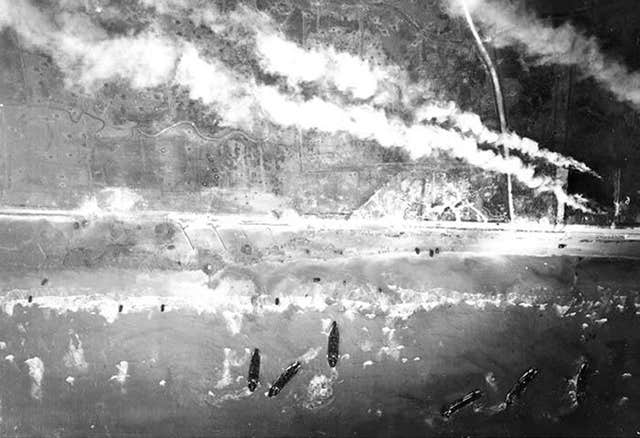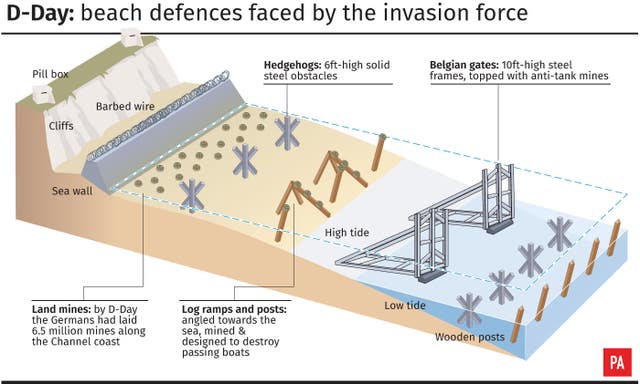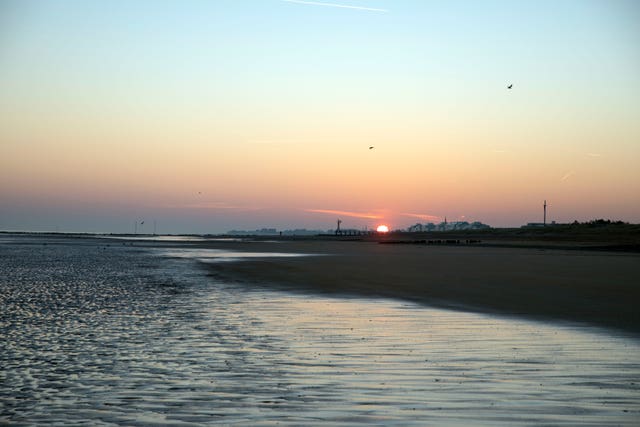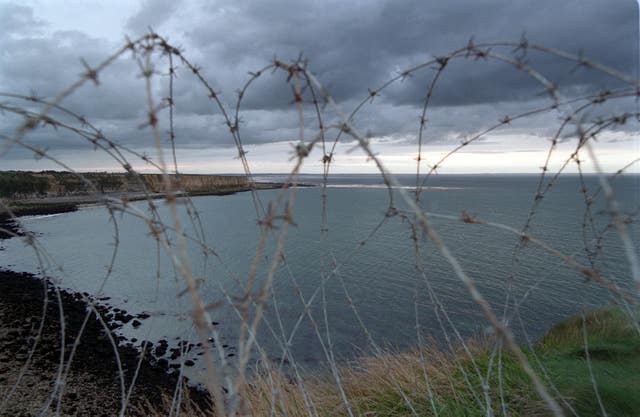The beaches where more than 130,000 troops landed for D-Day
The Allied nations landed more than 130,000 troops on five beaches on D-Day in the biggest seaborne invasion in military history.
Spread across a 50-mile stretch of coastline in Normandy, the five beaches were known by their codenames.

SWORD:
– The easternmost of the five beaches targeted on D-Day, Sword was assaulted by the 3rd British Infantry Division.
The British were to advance inland as far as the strategically-important town of Caen and line up with the British airborne forces east of the Orne River/Caen Canal.

Sword beach in Normandy, France
The 3rd Division established a solid bridgehead and almost reached Caen, but the town was not to fall to the Allies until mid-July.
By the end of the day, some 29,000 men had landed at Sword and there were around 630 casualties.
GOLD:
– Nearly 25,000 men from the British 50th Division landed on Gold beach – at the centre of the landing zones – on D-Day.
The aim was to capture the inland town of Bayeux and the Caen-Bayeux road, and to link up with the Americans at Omaha.
But there were difficult obstacles to overcome, including German resistance and high winds causing the tide to rise more quickly than expected.

An aerial view of Gold Beach on D-Day
Although they did not link with the US soldiers in the west, the British troops did join soldiers from the Canadian 3rd Division who had landed on Juno beach in the east.
By the end of the day, 413 men were killed or wounded on the beach, and 89 landing crafts were destroyed.

JUNO:
– The assault landings on Juno between Gray-sur-Mer and Bernieres-sur-Mer were made by the Canadian 3rd Infantry Division.
The aim was for Canadian troops to secure the beach and join up with British forces on Gold to the west and Sword to the east.

The sun rises over Juno beach near Graye-sur-Mer in France
Choppy seas hampered the landings but the troops were able to forge a bridgehead and liaise with the British 50th Division.
Despite making the deepest penetration of any land forces on June 6, the Canadians eventually had to withdraw from their position 5km from Caen.
Juno was heavily defended and casualty figures were high among the total of 21,400 men who landed there on D-Day.
OMAHA:
– Casualty figures on Omaha were higher than on any other beach, with more than 2,000 Americans killed or wounded.
The first wave of landings by the 1st and 29th American Infantry Divisions was at 6.30am.
Initial Allied air and naval bombardments failed to knock out the Germans, whose heavy guns had survived the attacks by being withdrawn and sited further to the rear.
Amid difficult terrain and with the whole beach overlooked by cliffs, some doubted whether Omaha should have been chosen.

An aerial view of Omaha Beach
The Allies also did not know that the experienced German 352nd Infantry Division was taking part in an anti-invasion training mission in the area and was able to reinforce coastal defence units.
German machine gun fire tore into the American troops, and at one point Colonel George A. Taylor reportedly said there were two kinds of people staying on the beach – “The dead and those who are about to die”.
Despite the challenges, the Americans showed incredible bravery to rally and drive the Germans inland, and they were able to gain a small foothold on the beach by the end of the day.
The Steven Spielberg-directed war film Saving Private Ryan brought the horrors of war on Omaha beach to a new generation when it was released in 1998.
UTAH:
– The American 4th Infantry Division did not suffer the same grievous losses at Utah as their colleagues had endured at Omaha.
Luck played some part in that as strong currents swept the first wave of troops into a more lightly-resisted area, 2,000 yards south of their original target.

The view overlooking Utah Beach from Pointe du Hoc,
The US troops ensured that later assault waves also landed in this less-defended area, and within hours the bridgehead was secured.
Of more than 23,000 men from the 4th Infantry Division who landed at Utah, some 200 were killed, wounded or missing as they advanced around four miles.
The Press Association
Latest posts by The Press Association (see all)
- In Pictures: Party stalwart kept New Labour in touch with traditional supporters - November 21, 2024
- 6 easy indoor exercises to try this winter – and why they are good for you - November 19, 2024
- Martin Clunes: I can’t afford to retire – I’ve got too many horses - November 19, 2024
- How to avoid plant losses, flowering disappointments and container catastrophes - November 17, 2024
- John Lewis Christmas ad stars sister in last-minute dash back in time - November 14, 2024





















